FREE TEXT DEPENDENT QUESTIONING UNIT!
“Hey, I’m Quinn the Questioning Quail; use me when you read. Questions are the way to get the information you need. Good readers ask questions to help them understand; They read the text to find the answers—that’s a smart plan.” 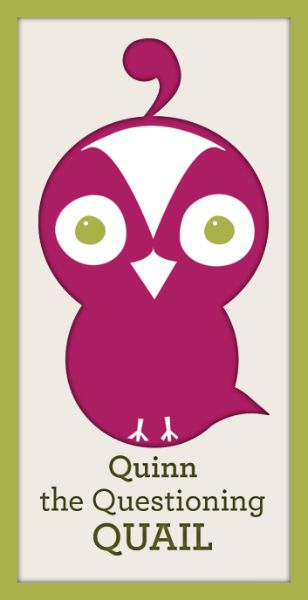 Quinn the Questioning Quail is one our comprehension strategy animals in Hazel’s Reading Roost. Quinn supports students in asking and answering questions while reading. Read more about Quinn’s strategy below…
Quinn the Questioning Quail is one our comprehension strategy animals in Hazel’s Reading Roost. Quinn supports students in asking and answering questions while reading. Read more about Quinn’s strategy below…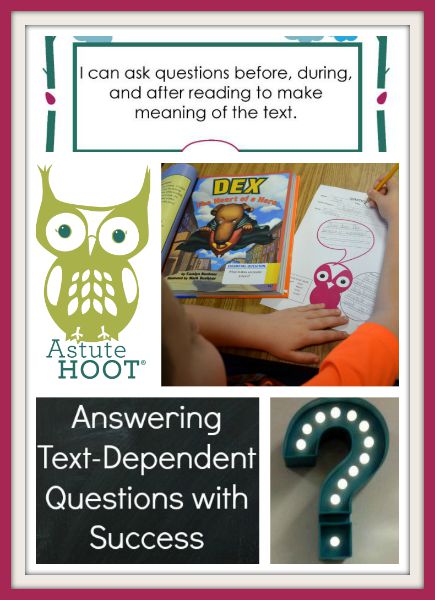 WHAT is questioning? Efficient readers continually form questions before, during, and after reading to assist in comprehending text. Self-formulated questions provide a framework for active reading by directing readers’ attention to key information. Teacher use of essential questions and text dependent questions helps students make deeper meaning of the text.
WHAT is questioning? Efficient readers continually form questions before, during, and after reading to assist in comprehending text. Self-formulated questions provide a framework for active reading by directing readers’ attention to key information. Teacher use of essential questions and text dependent questions helps students make deeper meaning of the text.
WHY is questioning important? When readers ask and answer questions while they read, they are involved in a process of active inquiry. They are not only interacting with the text to make meaning, but they are also monitoring their comprehension.
HOW do I teach questioning? Explain that Quinn helps readers ask and answer questions before, during, and after reading to make meaning. Incorporate think-alouds that focus on using a variety of text-dependent questions and model citing textual evidence to generate answers. Start with an engaging, yet rigorous, age-appropriate text. Look at the cover and record a few questions on Post-Its, thinking aloud as you go. Use text features such as the title and cover to help generate the question. Example questions include:
- What is the story about?
- How can you describe the character like?
- What is the problem in the story?
Pre-select stopping points within the text to ask and answer questions. While reading, answer the questions when applicable, writing answers and textual evidence (such as page numbers) on Post-Its. Record new questions as they naturally arise while reading such as:
- What is the main idea?
- How am I visualizing this part of the story?
- Where does this story take place?
- What does this remind me of?
After reading, ask follow-up questions:
- Was my prediction correct? What textual evidence supports this?
- What connections can I make?
- What would happen if…?
Teachers can also strengthen comprehension by incorporating multiple readings of the same text and planning different text-dependent questions for each read, increasing in complexity and rigor with each subsequent reading. 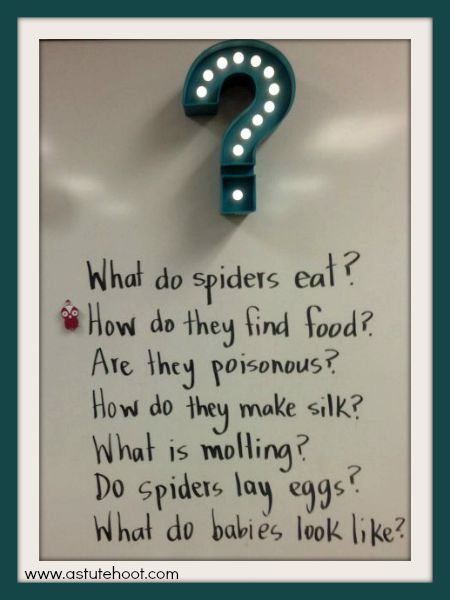 During the first read, ask literal-level questions that require students to focus on key details and story structure in order to grasp the main idea. “What is the setting of the story?” and “What is the problem in the story?” are two literal-level questions. In the second read, focus on vocabulary and author’s purpose. Ask questions such as, “How does the story change from the beginning to the end?” and “What words did the author use to create the mood in the story?”. In the third read, ask questions that encourage students to infer, form opinions and make arguments and cite textual evidence for support. Questions such as, “What would happen if the character had…..?” or “Which character do you relate to and why?” and “How would you change the ending?” utilize higher-thinking skills and help students create meaningful connections with text. When planning questions for students, be sure to consider the following:
During the first read, ask literal-level questions that require students to focus on key details and story structure in order to grasp the main idea. “What is the setting of the story?” and “What is the problem in the story?” are two literal-level questions. In the second read, focus on vocabulary and author’s purpose. Ask questions such as, “How does the story change from the beginning to the end?” and “What words did the author use to create the mood in the story?”. In the third read, ask questions that encourage students to infer, form opinions and make arguments and cite textual evidence for support. Questions such as, “What would happen if the character had…..?” or “Which character do you relate to and why?” and “How would you change the ending?” utilize higher-thinking skills and help students create meaningful connections with text. When planning questions for students, be sure to consider the following:
- Generate questions that require students to read the text to answer the question and cite textual evidence when answering
- Provide an opportunity for students to determine meaning of new vocabulary in context
- Include scaffolding so that all students understand what is being asked
- Require students to make predictions, inferences and text connections
- Use a variety of question levels to promote higher-level thinking (e.g., Blooms Taxonomy).
Three different types of Questioning Quail Reproducibles are included:
- Question and answer: This graphic organizer allows students to record questions and answers about a text (student or teacher generated). A space to cite page number for textual evidence is included. In addition, a version with word banks is provided for scaffolded support for students as needed.
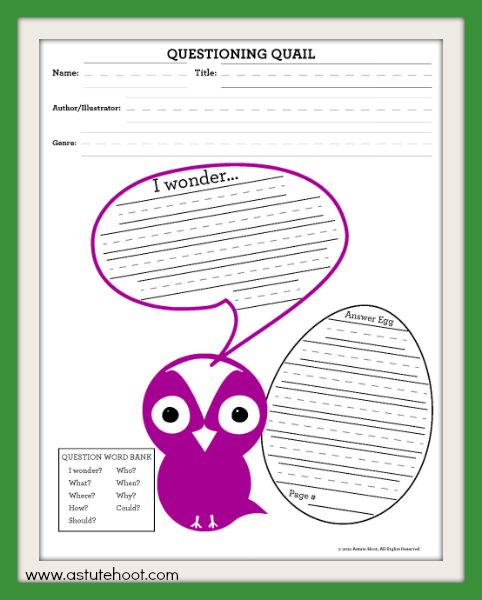
- O.W.L: This graphic organizer has three columns (Observe, Wonder, Link) to allow students to make observations, ask questions, and create connections as they read. Provide a brief overview of each column on the graphic organizer. Explain that they will use the Observe column to record facts and their observations; the Wonder column to record any questions about a topic; and the Link column to record their connections, answers to questions, and reflections.
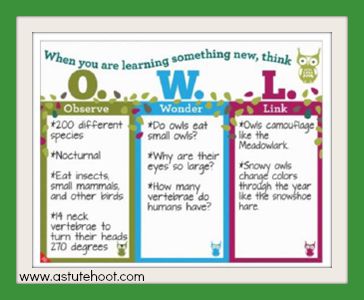
- Vocabulary: Teaching vocabulary in context is essential. Use this graphic organizer to build understanding of key vocabulary words from the text. Students can record the word, definition, sentence and picture. Several pages can be stapled together to create a vocabulary booklet for each text.
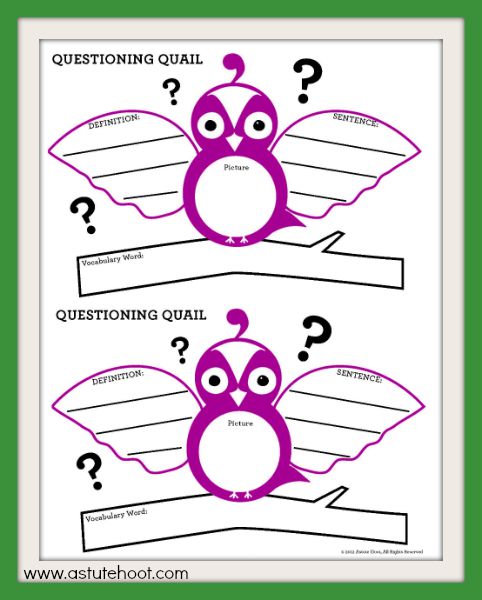 WHEN should I use questioning? Explicit reading strategy instruction should be included in a balanced literacy program. Quinn the Questioning Quail can be incorporated into various components of literacy lessons. Here are some specific examples of when to use Quinn:
WHEN should I use questioning? Explicit reading strategy instruction should be included in a balanced literacy program. Quinn the Questioning Quail can be incorporated into various components of literacy lessons. Here are some specific examples of when to use Quinn:
- Guided Reading: Review the strategy by reading the Quinn the Questioning Quail Poem. Using a think-aloud with your selected guided reading text, ask questions before reading using the front cover to help generate questions. Model recording your question(s) on the Questioning Quail Reproducible. Distribute Questioning Quail Reproducibles and copies of the guided reading text in which you have pre-selected ideal stopping points to guide students to generate questions. Use Quinn’s Anchor Chart to encourage students to record questions on the Questioning Quail Reproducible. Discuss questions together and then have students read on to find answers. Prompt students to record answers and textual evidence used in Quinn’s answer egg.
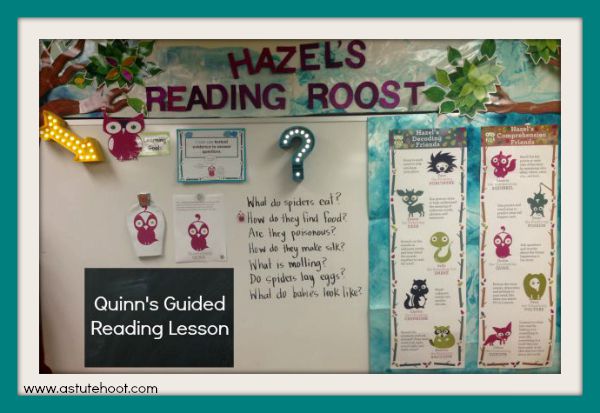
- Questioning Quinn Center: Create a portable reading center: Place Quinn Questioning Quail Reproducibles and a book or text at students’ reading level in a large manila envelope with a copy of the Quinn Questioning Quail Poem glued onto the front. Instruct students that during center time they are to take an envelope to their desks and use the Questioning Quail Reproducible to record questions and then read to find the answers in the text. Create several portable Questioning Quail centers using a variety of leveled texts.
- Reading Response Journal: Use the Reading Response Journals to increase independent reading accountability at school and home. Instruct students to log independent reading information and respond to the text using one or more of comprehension strategy animal prompts. To reinforce the predicting strategy, encourage students to use Questioning Quinn’s sentence stems in their responses.
Helpful Hints:
- Create Reading Response Journal. Print the Reading Response Journals to create individual journals for each student. Print cover page on cardstock and laminate. Use a blank piece of laminated cardstock for the back cover. Print several copies of the Reading Response Log page and staple or bind together to form a journal. These journals can be used in class during independent reading time or sent home to record reading time for homework. The Reading Response Journal sets a purpose for independent reading and promotes student ownership and accountability. Journal responses allow teachers and parents to easily assess understanding and engagement.
- Purchase Quality Reading Response Journals. Use these Astute Hoot Reading Comprehension Journals from Really Good Stuff to practice the questioning strategy along with other comprehension strategies. Hazel and friends guide students through a variety of comprehension strategies in this helpful journal that can be used with authentic literature or basal readers.

- Display Questioning Quail Anchor Chart. Print and post the Questioning Quail Anchor Chart located in this unit. Display near your guided reading center for easy reference. Encourage students to use the sentence stems during discussions and in their written responses.
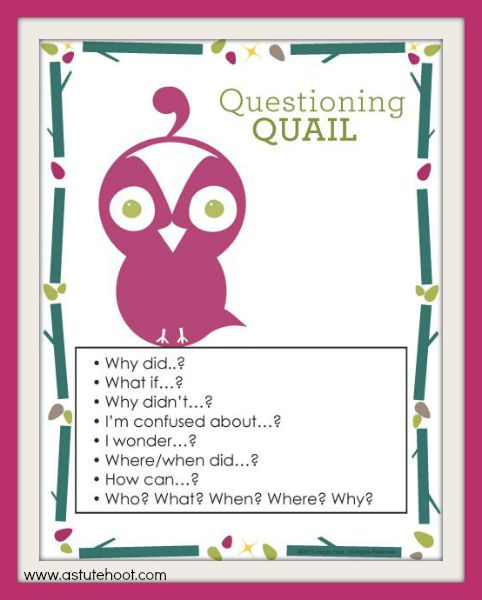
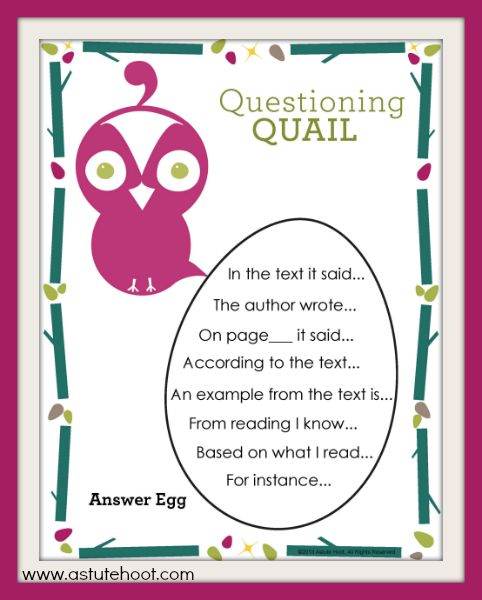 Quinn’s unit is perfect for general education, special education, RTI and reading intervention. Download the complete unit here: https://www.teacherspayteachers.com/Product/Distance-Learning-Text-Dependent-Question-Unit-Quinn-Questioning-Quail-1736187
Quinn’s unit is perfect for general education, special education, RTI and reading intervention. Download the complete unit here: https://www.teacherspayteachers.com/Product/Distance-Learning-Text-Dependent-Question-Unit-Quinn-Questioning-Quail-1736187

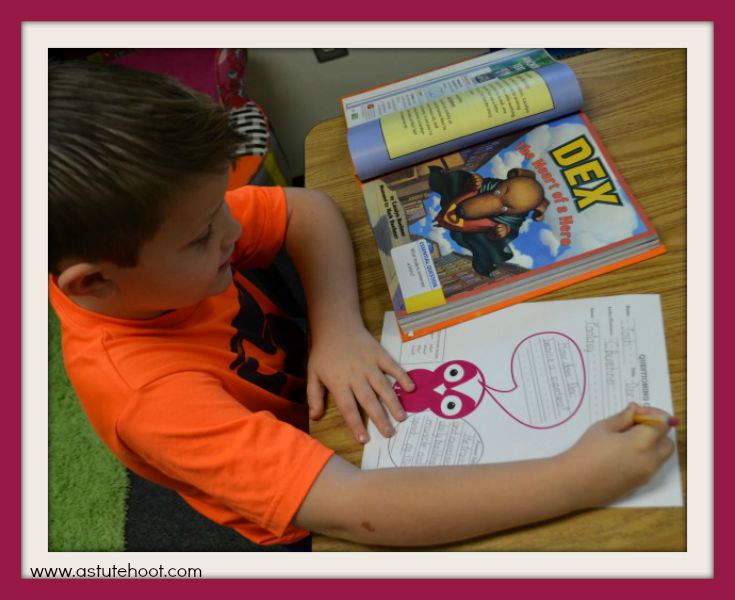
2 Comments
Hi Elizabeth! Thanks for stopping by. All of our Reading and Math strategies units are perfect for students in K-3. Paco the Pointing Porcupine is the best place to start for emerging readers.
Warmly,
Jen
I work at a daycare. Interested in products for ages 5 and up